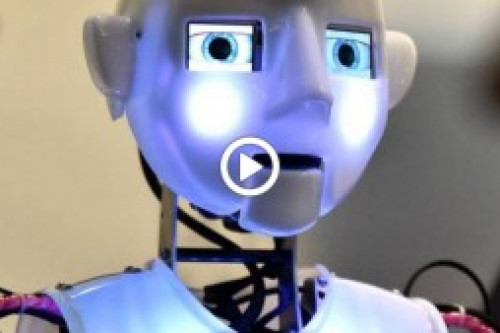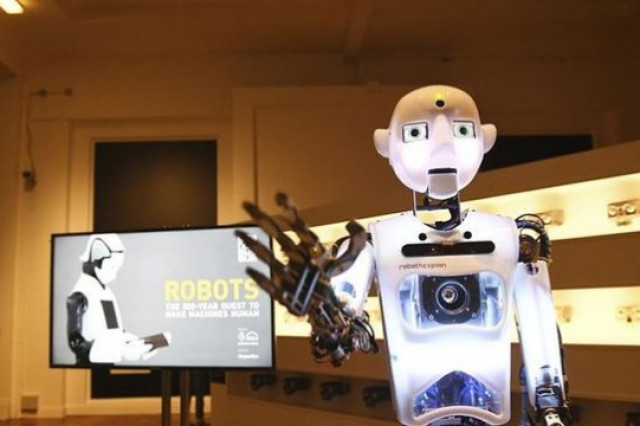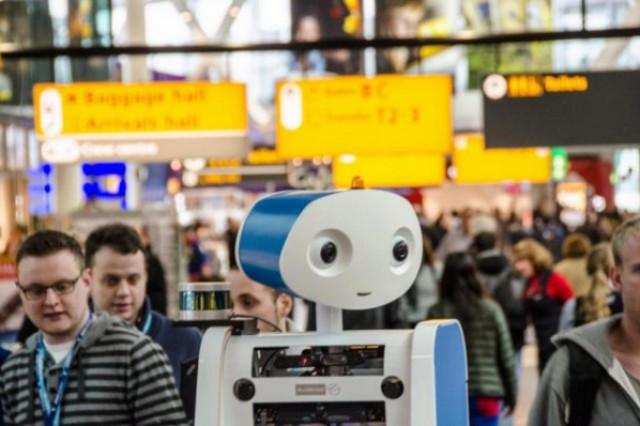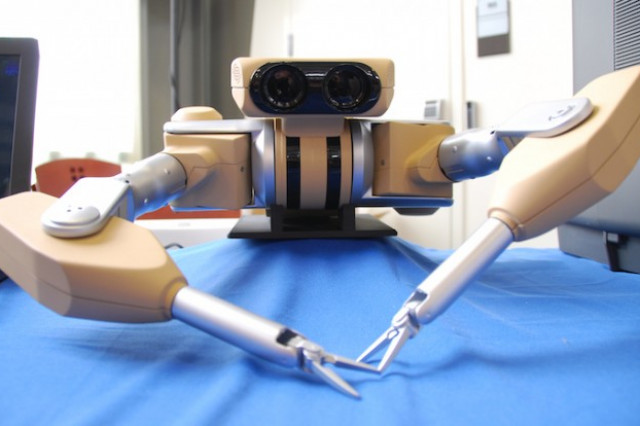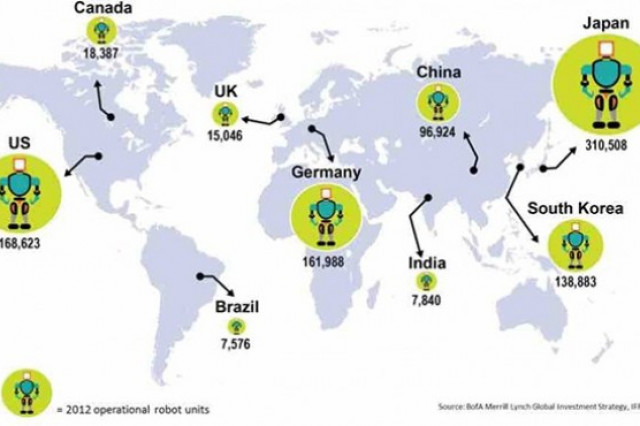If you are one of those who think that a robot can hardly replace you in your work, perhaps this article will demonstrate to you that you are wrong. Your opinion may be based on the fact that, in the past, the automation of the economy was limited to repetitive tasks such as mental calculations, copying text and images (computers and printers), or cleaning (dishwashing). However, technological improvements are occurring that will allow the robotization of non-repetitive tasks that until now were the exclusive domain of people. We will now analyze the impact of these changes on the world of work, considered by some experts as the Fourth Industrial Revolution.
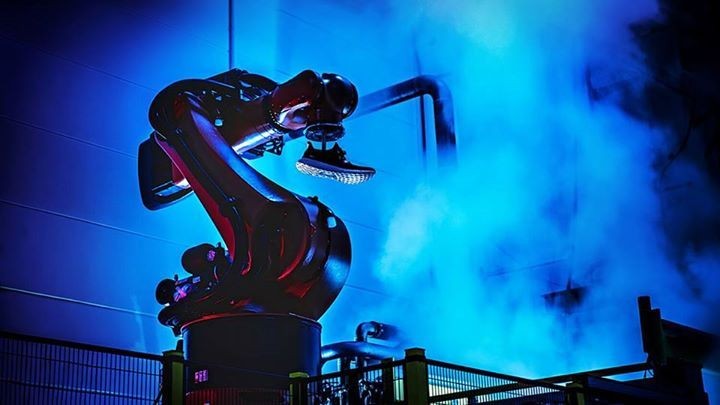
The behaviour of a robot is governed by an algorithm, that is, by a list of procedures previously established by a human programmer. For example, you can tell your computer to sell 100 shares only if they exceed 50 Euros. Traditionally, for a robot to perform a task, it was necessary for a human programmer to understand the sequence of steps necessary to carry it out and be able to clearly specify them. However, recent improvements in sensory and processing capabilities, coupled with the development of big data and artificial intelligence, are allowing automation to extend to almost all kinds of non-repetitive tasks such as vehicle driving (the Google driverless car) or medical diagnosis (the IBM Watson robot).
Thanks to the big data, robots possess a large database with which to experiment and learn which algorithms work best. In addition, they can share their experiences and thus learn from the mistakes and successes of others. For example, at Memorial Sloan-Kettering Cancer Centre in New York, IBM's Watson robot provides potential diagnoses and treatments from an extensive database of medical reports and scientific articles. Google's car compares information from its sensors with a detailed road map, which specifies the exact position of streets, signs and obstacles, to decide in real time whether to steer, brake or accelerate according to what the other cars or pedestrians are doing.
These days, 45% of tasks could be automated
The technological advance is of such magnitude that a study by McKinsey estimates that today 45% of the tasks existing in the USA could be automated. But do not confuse tasks with jobs: a job or profession involves multiple tasks, such as social interaction or physical exercise. To evaluate the impact on employment, we need to analyze how many of the tasks in each profession are at risk of being automated. That is precisely what two professors of the University of Oxford, Carl B. Frey and Michael A. Osborne have done.
In a world in which robots are able to perform absolutely all tasks, the distribution of income and wealth, rather than the scarcity of resources, would be the main reason for existing as far as economists are concerned
In their analysis, they identify three groups of tasks that technology will not yet be able to perform in the next two decades:
- Perception and manipulation in cluttered environments
- Creative intelligence (make a joke)
- Emotional intelligence (persuading someone)
Depending on the importance of these three types of tasks, Frey and Osborne calculate the probability that each profession can be automated. Thus, for the USA, they have drawn up a list of 702 professions and the probability of automation associated with each one. If we convert its American classification to the Spanish one, we can estimate the effect on a list of 485 professions in Spain. The first table shows examples of professions according to their risk of automation.
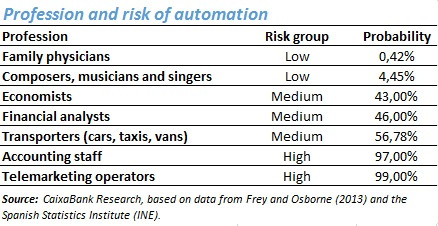
As we have pointed out, we estimate that technology is already capable of automating qualified professions (look at risk associated with accounting, financial analysts and economists), while those in which human interaction and creativity are more important (family physicians, musicians) are the most protected. This is also illustrated by the first graph, where we have grouped the professions into nine large groups. Scientists (creativity) and managers (social interaction) have little risk, while administrative workers are concentrated in the high-risk group.
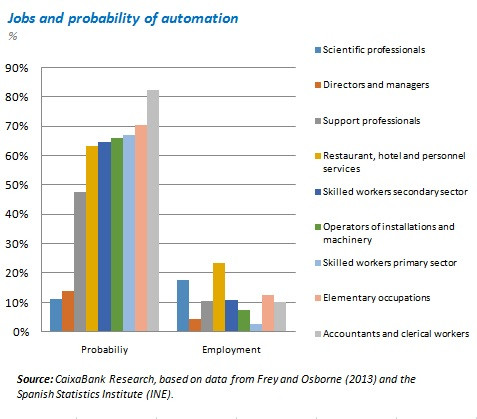
In Spain, 43% of jobs could be automated
According to our estimates, overall 43% of jobs currently in Spain have a high risk (with a probability greater than 66%) of being able to be automated in the medium term, while the rest of the jobs are left divided equally between the medium risk group (between 33% and 66%) and low risk (less than 33%).
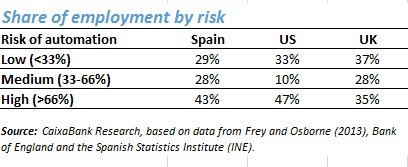
However, the potential for robotization of the economy should not be confused with the disappearance of jobs. Technology destroys professions, but not the possibility of working. The automation of the professions that we know today provides the possibility of reorienting the nature of the work, freeing up the workers so that they can dedicate themselves to new activities in which they bring out their full potential, as they already did the vacuum cleaner or the washing machine in the domestic field. Most workers spend much of their time on tasks where they lose their comparative advantage over the robot, so there is great potential to create new professions if institutions and individuals seize the opportunity.
Overall 43% of jobs currently in Spain have a high risk (with a probability greater than 66%) of being able to be automated in the medium term
Robots have a great logical and management capacity for big data, but inspiration, intuition and creativity are far beyond their reach.
Technological improvements offer the opportunity to enrich society as a whole. But beyond the technological potential, there are important economic determinants in relation to their adoption and social impact. On one hand, companies will adopt the technology unless it is cheap enough. For example, in the last decades, the reduction of the cost of computers has led to the replacement of workers with intermediate skills who perform repetitive tasks which are easy to specify in an algorithm, which has contributed to labour market polarization and to an increase in inequality. This brings us to another relevant economic aspect: the distribution of new wealth. Our data indicate a negative correlation between the probability of automation of a profession and its average annual salary, suggesting a possible increase in short-term inequality.
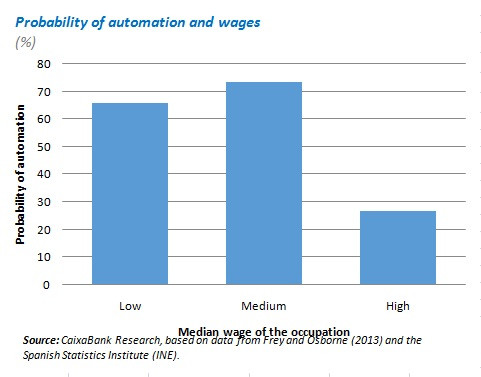
In the long run, in a world in which robots are able to perform absolutely all tasks, the distribution of income and wealth, rather than the scarcity of resources, would be the main reason for existing as far as economists are concerned. Provided such a profession continues to exist.



